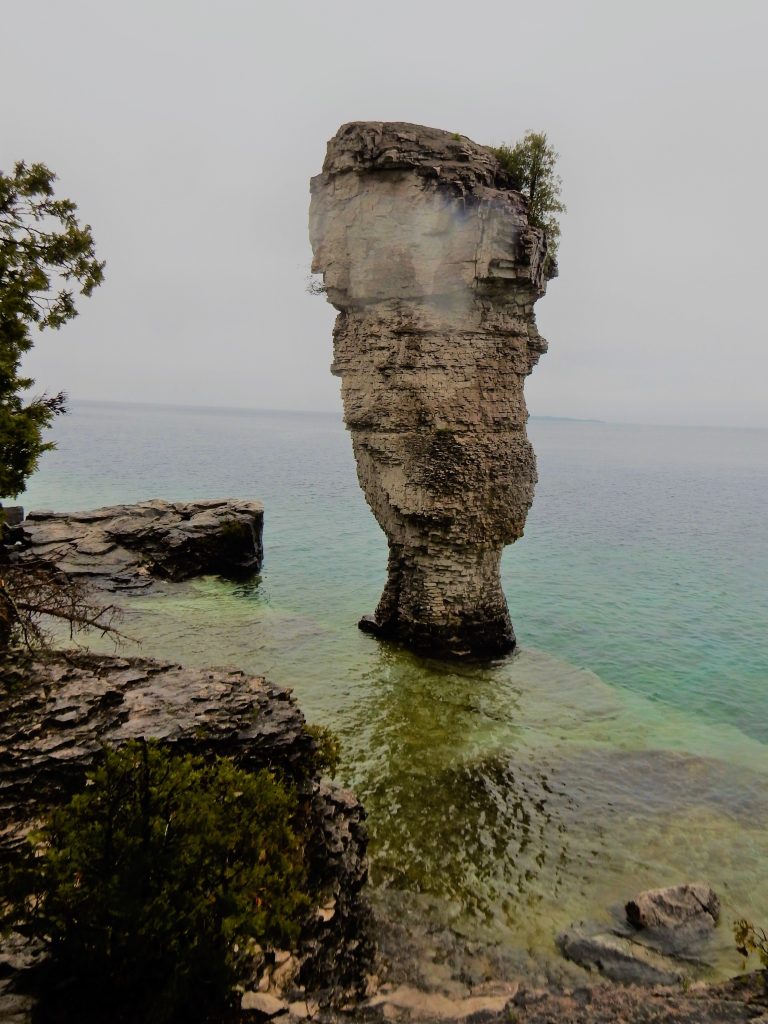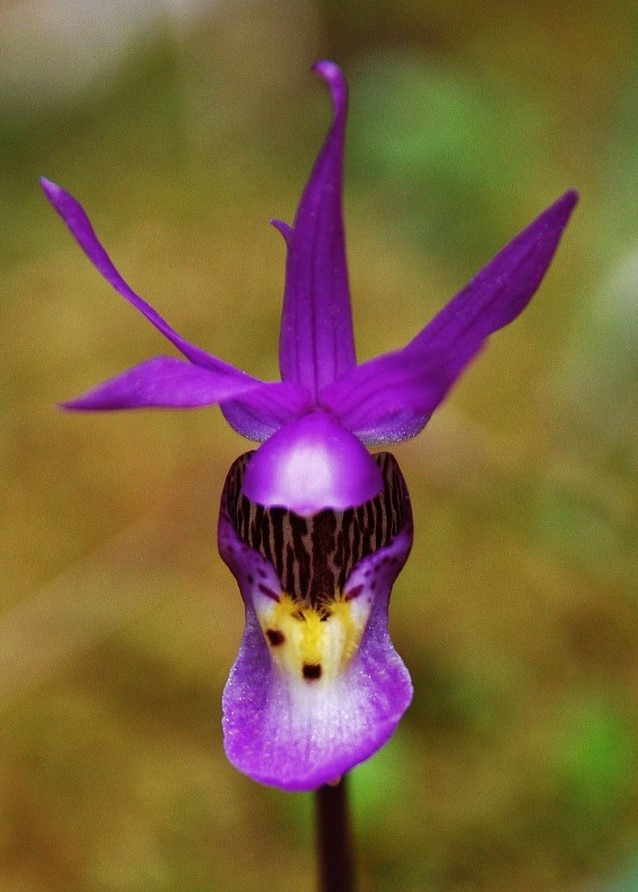THE BRUCE

Like most kids, I loved games of make-believe. One of my favorites was playing spy. Whether it was lying prostrate in the back of my parents’ station wagon imagining myself being chased by Russians (seatbelts were optional then), jotting down quirky observations ofpeople in a little green notebook, hiding at the top of the stairs to eavesdrop on the grown-ups, or donning my mom’s dresses and heels to form a disguise, I was always pretending. Commonplace events took a sinister turn. No one was who they seemed, and every thing was a mystery I was determined to solve. In other words, I wanted to be Nancy Drew!
For those of you who their cut their teeth on those books, you’ll remember the girl detective was adept at managing watercraft and many of the stories took place near lakes or involved water sports. Nancy Drew would have been right at home in a place I visited last June - the Bruce Peninsula.[1]
In every good mystery story the setting, whether it be exotic or mundane, is as important as the protagonists. So let’s start with the basics of the Bruce Peninsula - location. “The Bruce,” as it’s known in local vernacular, juts out like an index finger into the crystal cool waters of Lake Huron, approximately 250 km northwest of Toronto. It’s part of Bruce County, Ontario and hosts two national parks; Bruce Peninsula NP and Fathom Five National Marine Park. Some of what makes the area geologically unique is that is contains part of the Niagara Escarpment[2] on the east side along the Georgian Bay. This contributes to an unusual phenomenon botanists find interesting in that the hardiness zones on the peninsula change from east to west rather than north to south as in most places, with the cooler side being on the east as elevations rise. (More about plants later).
The Bruce is an important part of the migratory bird flyway and a unique natural area, being home to the largest remaining untouched forest in Southern Ontario, otherwise known as a “mega-woodland” where you can find some of the oldest trees in North America and many other plant and animal species like black bear and Eastern Massasauga rattlesnake. While there may be plenty of wild creatures, there isn’t much on the Bruce in terms of creature comforts. That’s part of its allure, but it also means you need to go prepared. (Nancy was always infinitely prepared, you’ll recall.)
As you head north from Toronto, you’ll find quaint little towns like Orangeville and Owen Sound where the activity is centered along main streets flanked by funky shops and restaurants. Eventually this gives way to the more sparsely populated Highway 6, an evergreen-lined, two-lane road which transects The Bruce vertically from northto south. Along it, you’ll find a few hardware stores, the ubiquitous Tim Horton’s, a grocery store, and a few mom-and-pop fish ‘n chips stands, where you can gear up and have a snack.
The Bruce is a goldmine of outdoor activities. In fact, if you’re not partial to fishing, hiking, camping, kayaking, or boating, there’s little else to attract you – unless you consider pure, unadulterated nature insignificant. I wasn’t there to do any of those things, though. I was part of a convocation known as the Native Orchid Conference,[3] and the Bruce Peninsula (specifically, the town of Tobermory) was the locale for the organization’s annual symposium. In case you were wondering … the Native Orchid Conference or NOC is a non-profit group focused on the study and conservation of native, mainly terrestrial orchids of North America. Consisting of members from around the globe, the organization’s primary activity is hosting a yearly conference, where participants listen to scientific lectures before heading off into the bush to find and photograph flowers.
Tobermory is a like a shining pot of gold waiting for you at the end of Route 6. It sits at the northernmost point of the peninsula where two harbors, Big Tub and Little Tub, carve themselves into the landscape. Most of the activity centers on Little Tub Harbor and its marina. There you’ll find The Tobermory Princess, a modest, family-run hotel with restaurant. You’ll also find eclectic boutiques focused on all things nautical and outdoorsy, quaint coffee shops, and restaurants like the Tobermory Brewing Company and Grill, which serves up hefty burgers, a healthy pumpkin and sunflower seed hummus and some tasty brews. But you can’t leave the Bruce without having at least one fish n’ chips meal complete with vinegar in a spray bottle! Lee’s was touted as the place to get it, but unfortunately our limited schedule precluded us from having the full Tobermory experience. A good excuse to go back!
At the heart of Tobermory is narrow Little Tub Harbor. Here is where you can park your boat or charter one for a snorkel tour or a dive. Tobermory happens to be the “freshwater scuba diving capital” of the world with 24 shipwrecks and a unique underwater topography that divers find appealing. From Little Tub Harbor one can also get on board the MS Chi-Cheemaun (Ojibwe for “Big Canoe”), a ferry providing daily passenger/vehicle service between Tobermory and the town of South Baymouth on Manatoulin Island, the world’s largest freshwater island. But our group of conference members were on a special mission, so we opted for the jet boat via Blue Heron Cruises[4] to take us to Flowerpot Island. Some housekeeping here: Joining the cruise takes a bit of maneuvering. The ticket office is in one location, car parking in another. A short but steep walk through town takes you to where your tickets are validated before gathering at the embarkation point.
This is where the plot, and pardon the pun, the fog thickens. Although the Great Lakes have an overall moderating effect on climate, if you’ve spent any time there, you know how mercurial the weather can be, particularly in summer. The morning we set out for Flowerpot Island was rainy and cool. As we boarded, our skipper passed out blue plastic ponchos – more to keep our bums from getting damp than to mitigate the rain and mist. We settled into our seats and off we went on the Flowerpot Express!
The unique rock formations that lend the island its name are formally known as sea stacks.[5] These formed thousands of years ago when the last glaciers retreated. Flower Pot Island is composed of dolomite, which was strong enough to survive the grinding of the glaciers. After the last ice age, when the glaciers retreated, surface water filtered through cracks in the earth and eroded “softer” rock behind the formations. Wind, rain, and wave action did the rest, resulting in the towers of rock we see today.
Remember, the objective of our visit was to observe the plethora of orchid species which occur naturally and in abundance on The Bruce. Yellow Lady’s Slippers, elusive Coral Roots, and ethereal Listera cordata with their millimeter-sized blossoms were our targets. But the gems of the Bruce are Calypso bulbosa or the Fairy Slipper orchid. Calypso are diminutive, rare, and quite beautiful, which puts them at the top of most orchid hunters’ checklists.
As in any good novel, there are plot twists to follow and problems to overcome. It was cool and wet like everywhere else in the eastern half of North America last year. Want to see a grown man cry? Tell him the bloom time of the orchids is a week or two behind schedule because of below normal temperatures. But don’t fear – orchid hunters are perennial optimists. So what if the plants aren’t in bloom? We can still look at leaves and inflorescences in spike. So what if it’s raining and the ground is saturated? We can still writhe on our bellies to find just the right angle to point our macro lenses. However, Calypso are an entirely different animal. They’re the Holy Grail, and some people will stop at nothing to find them.
With wooded trails, hidden coves, mist, and place names like Devil’s Monument, Old Woman’s River, Singing Sands, Cave Point, and Spirit Rock, The Bruce is an ideal place for nature lovers who like a little intrigue mixed in with their botanizing. And yes, orchid hunters are not immune to some minor subterfuge in order to have the plants all to themselves. Sleuths refer to them as “red herrings,” but in the orchid world it’s known as the vague direction, the slip, or failure to divulge. Some of this has merit. Unscrupulous people with heavy feet can cause damage – or even worse, dig up plants. When a few people in our group got wind of the exact location of a few Calypso, they sent the majority of us off on a wildgoose chase culminating in a dead-end trail. Said scofflaws surreptitiously went off trail, found the plants, and returned gleefully boasting to the rest of us about their “good luck.” Criminal!
Orchid hunting is a lot like spy work. There are clues given by fellow explorers. There are hazards – black flies, mosquitoes, bogs of uncertain depth, ticks, chiggers – all must be overcome to reach your goal. You sometimes have to “trespass.” You frequently rely on cryptic messages to get to the final prize. You get help on where to look fromclues like companion plants – in this case, false Solomon’s seal, trillium, and Indian cucumber root. But in the end, just as Nancy always solves the case and the bad guys get exposed and all is well with the world, the same was true for us. We found the orchids, took our photos, and reveled in nature’s mysteries and the beauty of the Bruce Peninsula. Although I’m pretty sure Nancy Drew would have gotten those fish n’ chips!
Travel Notes:
Bruce Peninsula essentials: (1) Apassport (if you’re not Canadian); (2) Rain gear; (3) Insect repellent; (4) Hiking shoes; (5) Dress in layers; (6) Camera
Other Notes:
*If you’re really adventurous you can volunteer to man oneof the Flowerpot Island Lighthouse. It’s a 3 week gig. Caretaker duties include performing light maintenance and greeting visitors.
*Parking: The biggest mystery on The Bruce is the obsessionwith parking. In Tobermory and surrounds you’ll find parking kiosks throughout the park, even along wooded roads.

[1] The Bruce Peninsula wasnamed for James Bruce, 8th Earl of Elgin and Governor General of Canada from 1847-1854. One of his less savory claims to fame is the burning of the Old Summer Palace in Beijing during the Second Opium War while holding the position of High Commissioner and Plenipotentiary of China and the Far East.
[2] The Niagara Escarpment is essentially a steep slope running in an east/west direction from New York and Ontario through Michigan and Wisconsin into Illinois. The area holds a UNESCO World Biosphere Reserve designation as it has some of the oldest forest ecosystem in North America. As its name implies, the escarpment is best known as the cliff over which Niagara Falls descends.
[3]Native Orchid Conference: https://www.nativeorchidconference.info/
[4] Blue Heron Cruises: https://www.cruisetobermory.com/
[5] Point of clarification. SeaStacks can be found on the Bruce, not Sleestaks, which are only known to exist on The Land of the Lost. See https://landofthelost.fandom.com/wiki/Sleestak
